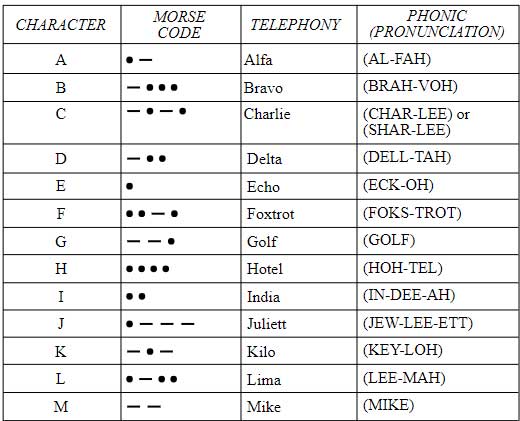+86 15093323284 hams@ailunce.com
The Historical Origin of NATO Phonetic Alphabet

Alphabet interpretation is widely used in amateur radio communication.
Due to the low output power of amateur stations and the complicated factors of radio wave propagation, the distortion or fading of the received speech signal is serious, which affects the analysis and identification of information. Especially in DX communication, some non-English areas have different accents, and many misunderstandings are easy to make during a call. In order to solve these problems, stations all over the world use letter interpretation in voice communication, call sign, name or QTH (radio location) The letters and numbers in etc. use this interpretation to avoid misunderstandings.

In 1927, the International Telecommunication Union (ITU) standardized and adopted the first internationally recognized letter interpretation method for maritime communication services, for communication between radio operators regardless of their native language. This letter interpretation improves the safety of navigation on sea vessels. In 1932, the ITU made some modifications to it and began to use it for civil aviation communications by the International Air Navigation Commission (ICAN, the predecessor of ICAO ICAO).

In 1941, during the Second World War, the British and American allied forces used different interpretations of letters, but due to the military needs of the Allied Joint Operations, the Allies unified the letter interpretation, such as "A" was unified. Interpreted as "able", "B" is unified as "baker", etc., in 1946, the ICAO meeting adopted the letter interpretation method that was unified during the continuation of wartime (because many flights after the Second World War) And the ground staff are from the Allied retired people), but people also realize that the interpretation of individual letters in this letter interpretation is only relevant to the English-speaking region, which seems to be disadvantageous for non-English speaking areas, so in order to target South America and the Caribbean In other regions, at this meeting, ICAO approved a second set of letter interpretation ("A-Ana", "B-Brazil", etc.) for simultaneous use.

Due to the coexistence of two sets of alphabetic interpretations, in 1947 the International Air Transport Association (IATA) presented a proposal to the ICAO at the Technical Conference in Nice to “suggest a single universal letter interpretation”. Around 1949, the University of Montreal, in collaboration with the ICAO Language Department, led Professor Paul Veneer to conduct a new international civil aviation letter interpretation after research through ICAO communications experts and all ICAO member governments. The law was officially implemented on November 1, 1951.
But then there have been problems, and some users have started to complain because these people believe that there are still many shortcomings in this letter interpretation. In 1952, ICAO decided to conduct further research and objective practical tests in its member states (through airlines, pilots, air traffic control, etc.). The test results came from 31 countries (but mainly in Canada, The United Kingdom, and the United States). Although the final conclusion confirms that the original letter interpretation method is basically stable, it still modifies the interpretation of five letters, that is, C, M, N, U, and X are replaced by Charlie, Mike, November, Uniform, and X-Ray.
Since March 1, 1956, ICAO has officially referred to this letter interpretation as "international radio letter interpretation" or "NATO phonetic alphabet". Many international and national organizations, including the North Atlantic Treaty Organization (NATO), the International Telecommunication Union (implemented by ITU in 1959), the International Maritime Organization (IMO), the United States Federal Aviation Administration (FAA), the American Radio Broadcasting Union (ARRL), etc. Implementation began one after another.
More information: https://en.wikipedia.org/wiki/NATO_phonetic_alphabet











